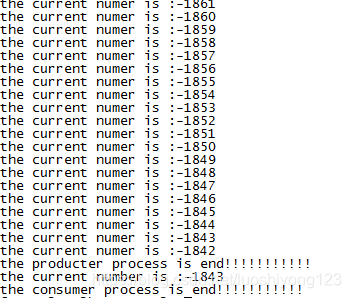1.知识点
pthread_mutex_t mutex //创建互斥区
pthread_mutex_init(); //初始化互斥区
pthread_mutex_lock(&mutex) //互斥区上锁
pthread_mutex_unlock(&mutex) //互斥区解锁
ps:当一个线程执行了pthread_mutex_lock(),但是未执行unlock,另一个线程执行到pthread_mutex_lock()会被阻塞
pthread_join(consumer,NULL); //在main函数中调用这句话后主线程变成阻塞状态,直到consumer线程结束返回。
pthread_mutex_trylock()的使用:这个函数是非阻塞调用模式, 也就是说, 如果互斥量没被锁住, trylock函数将把互斥量加锁, 并获得对共享资源的访问权限; 如果互斥量被锁住了, trylock函数将不会阻塞等待而直接返回EBUSY, 表示共享资源处于忙状态。
2.实例代码
#include<pthread.h>
#include<sched.h>
#include<stdio.h>
#include<unistd.h>
void * producter_f (void *arg); //生产者
void * consumer_f1(void *arg); //1消费者
int buffercount=10; //缓冲区计数
pthread_mutex_t mutex; //创建互斥区
int running=1;
int main(void)
{
pthread_t consumer_t1; //消费者运行参数
pthread_t producter_t; //生成者进程
pthread_mutex_init(&mutex,NULL); //初始化互斥区
pthread_create(&producter_t,NULL,(void*)producter_f,NULL);//创建生产者进程
pthread_create(&consumer_t1,NULL,(void*)consumer_f1,NULL);//1创建消费者进程
usleep(1); //等待线程创建
running=0;
pthread_join(consumer_t1,NULL); //等待消费者进程结束
pthread_join(producter_t,NULL); //等待生产者进程结束
pthread_mutex_destroy(&mutex); //释放临界区资源
return 0;
}
void* producter_f(void *arg)
{
while(running) //生产者写入上锁
{
pthread_mutex_lock(&mutex); //对缓冲区上锁
buffercount++;
printf("当前缓存为:%d\n",buffercount);
pthread_mutex_unlock(&mutex); //解锁
}
}
void* consumer_f1(void * arg)
{
while(running)
{
pthread_mutex_lock(&mutex); //保护数据一次只有一个线程操作
buffercount--;
printf("当前缓存为:%d\n",buffercount);
pthread_mutex_unlock(&mutex); //解锁
}
}
3.测试结果

这里明显消费者进程抢夺能力强





 本文深入探讨了线程同步机制中的互斥锁概念,包括互斥锁的创建、初始化、上锁与解锁过程,并通过生产者-消费者模型的实例代码展示了互斥锁在多线程环境下如何有效防止数据竞争,确保数据的一致性和完整性。
本文深入探讨了线程同步机制中的互斥锁概念,包括互斥锁的创建、初始化、上锁与解锁过程,并通过生产者-消费者模型的实例代码展示了互斥锁在多线程环境下如何有效防止数据竞争,确保数据的一致性和完整性。

















 1235
1235

 被折叠的 条评论
为什么被折叠?
被折叠的 条评论
为什么被折叠?










